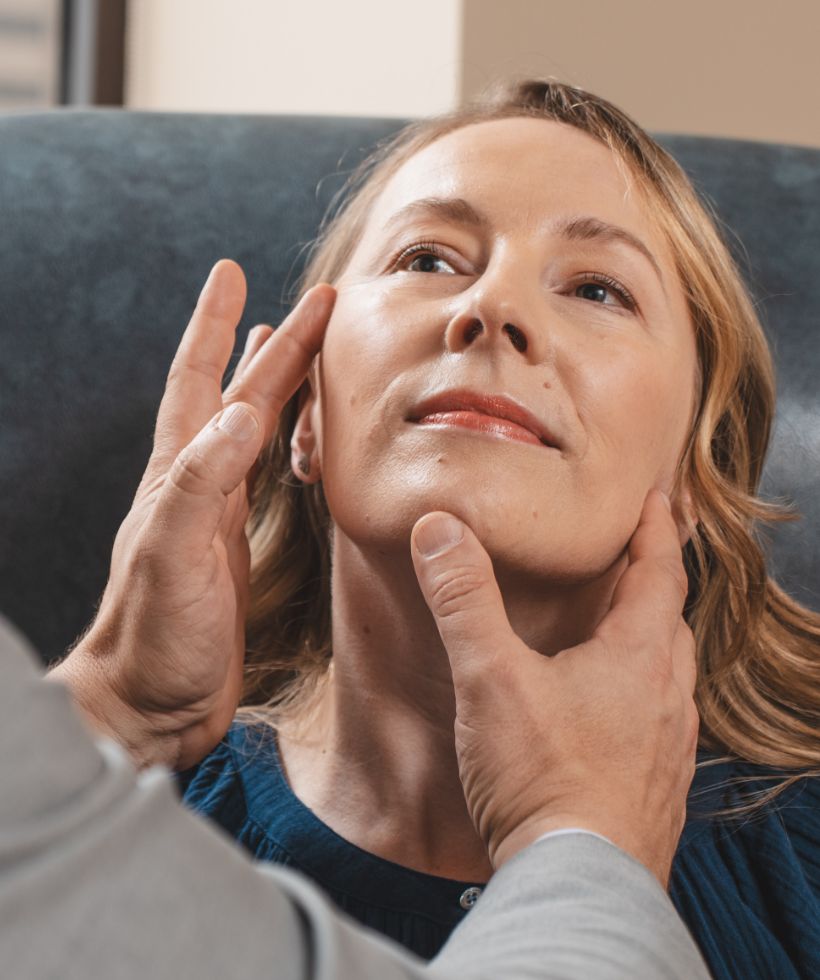Facelift
A facelift, or rhytidectomy (“rhytid” = wrinkle, “ectomy” = remove) is designed to rejuvenate the face and provide a more youthful appearance. As we age, several forces including gravity, stress, the muscles of facial expression, sun exposure and individual genetics cause our face to age. A facelift smooths signs of aging in the face and neck by tightening / re-positioning deeper, structural tissues, removing extra facial skin, and frequently replacing lost facial volume with fat grafting.
Get In Touch
How do I know when I’m ready for a facelift?
If you find yourself occasionally “correcting” what you perceive as troublesome facial features in the mirror by pushing backwards on the skin of the face or neck, a facelift may be the right option for you. Ideal facelift candidates often demonstrate some or all of the following features:
- Wrinkles of the face and / or neck skin
- Deep set grooves of the forehead, under the eyes, or on either side of the nose (nasolabial folds) or mouth (marionette lines)
- Hollowing of the cheeks, chin or lips
- Sagging or excess tissue of the cheeks, jowls and / or neck
- Tired, sad or even angry appearance in repose
- Appearing older than you feel or older than your actual age
Q. What is the best option for me, a facelift, or a non-surgical procedure?
A. Early signs of facial aging including fine wrinkles, loss of facial volume and skin blemishes may be improved with non-surgical procedures including Botox, fillers and / or laser resurfacing. While these procedures may slow the appearance of facial aging, there will come a time when the degree of tissue sagging, skin wrinkling and volume loss can only be treated surgically. This determination, as well as all your surgical and non-surgical options will be discussed with you at the time of your consultation.
Q. Does a Facelift include a neck lift?
A. Yes. Dr. Gougoutas views the lower face and neck as one unit that is seamlessly connected. While a neck lift may be done without a facelift, a facelift without a neck lift is very rarely performed.
Q. Does a facelift include upper and / or lower eyelid correction ?
A. Face lift planning is unique to each patient. While some patients may benefit from an upper and / or lower blepharoplasty (eyelid surgery) at the time of a facelift, others may benefit from addressing the eyelids during a separate procedure given the increased time of surgical recovery.
Q. Does a facelift include a brow lift?
A. Often a small, or limited-incision brow lift is recommended at the time of a facelift, though this is patient-specific. Dr. Gougoutas will evaluate your whole face, from hairline to the base of the neck, and arrive at a comprehensive treatment plan during your consultation.
Q. Where are the incisions for a facelift located?
A. Facelift incisions are well hidden within the hairline and natural creases of the ear. Once healed, these incisions will be nearly invisible to others. Most frequently, the incision begins at the lower edge of the sideburn, continues just in front of the ear, around the earlobe, behind the ear and ends within the scalp. While most patients require this full incision, others may require only a portion of this incision. To address the neck, there is often an additional, small incision just under the chin.
Q. What is recovery like?
A. In general, pain from a facelift is quite limited and easily managed with oral medication. You should, however, arrange for someone to assist you for at least the first 24 to 48 hours of recovery. Swelling and bruising will be most prominent during the first week of recovery and will diminish quickly thereafter. Depending on the specifics of your operation, swelling may take several weeks to a month to completely go away. Most patients can return to work within 1 to 2 weeks.
Q. When will I see the final results of my facelift?
A. Most patients see significant results from their facelift immediately, although subtle changes may continue to occur for up to a year after the procedure.
